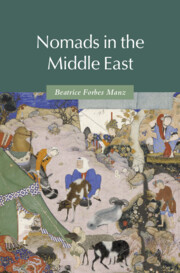Book contents
- Nomads in the Middle East
- Series page
- Nomads in the Middle East
- Copyright page
- Dedication
- Additional material
- Contents
- Figures and Maps
- Preface
- Maps
- Debate between Sheep and Grain
- 1 Introduction
- 2 Nomads in the Establishment of the Caliphate
- 3 The Rise of New Peoples and Dynasties
- 4 Turkic Tradition and Seljuqid Rule
- 5 Mongol Conquest and Rule
- 6 After the Mongols: Timurids, Turkmen and Ottomans
- 7 The Rise of Nomad Tribes,1500–1800
- 8 Nomads in the Modern Middle East
- 9 Conclusion
- Bibliography
- Index
4 - Turkic Tradition and Seljuqid Rule
Published online by Cambridge University Press: 12 November 2021
- Nomads in the Middle East
- Series page
- Nomads in the Middle East
- Copyright page
- Dedication
- Additional material
- Contents
- Figures and Maps
- Preface
- Maps
- Debate between Sheep and Grain
- 1 Introduction
- 2 Nomads in the Establishment of the Caliphate
- 3 The Rise of New Peoples and Dynasties
- 4 Turkic Tradition and Seljuqid Rule
- 5 Mongol Conquest and Rule
- 6 After the Mongols: Timurids, Turkmen and Ottomans
- 7 The Rise of Nomad Tribes,1500–1800
- 8 Nomads in the Modern Middle East
- 9 Conclusion
- Bibliography
- Index
Summary
This chapter describes the eastern steppe border of the Islamic world and the legacy of the Turk Khaghanate which had dominated the steppe. It argues that the Turks and Iranians had long been connected, even sharing some mythology. When Turkic nomads entered the Middle East, they employed the Persian bureaucrats of local dynasties. The chapter views the Seljukids as a group influenced by the steppe imperial tradition, and also well acquainted with the needs of settled populations. Following recent scholarship, it argues that despite the promotion of mamluk soldiers in the army, the Turkmen followers of the Seljuqs remained powerful and important. Continuing tribal immigration led to an increase of nomadic populations from Khorasan to Anatolia and the beginning of the Turkification of the western regions. The Seljuqids brought a significant cultural change by bringing the use of New Persian into western and central Iran as a language of administration and high culture, and introducing the use of a dual administration with a Turkic military and Persian administration. This Turco-Iranian synthesis became the court culture of Iran.
Keywords
- Type
- Chapter
- Information
- Nomads in the Middle East , pp. 81 - 108Publisher: Cambridge University PressPrint publication year: 2021



